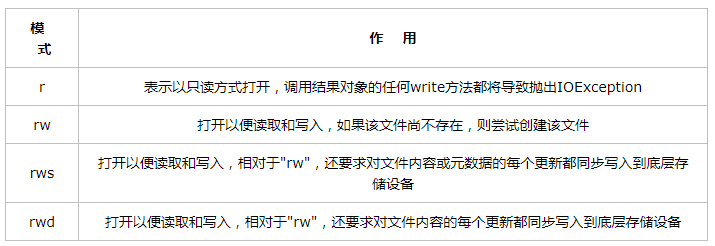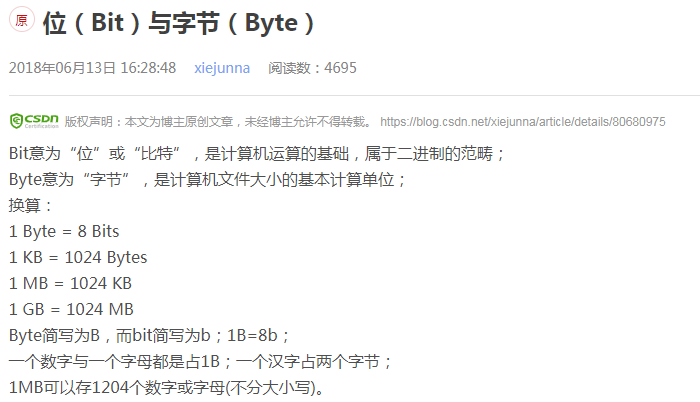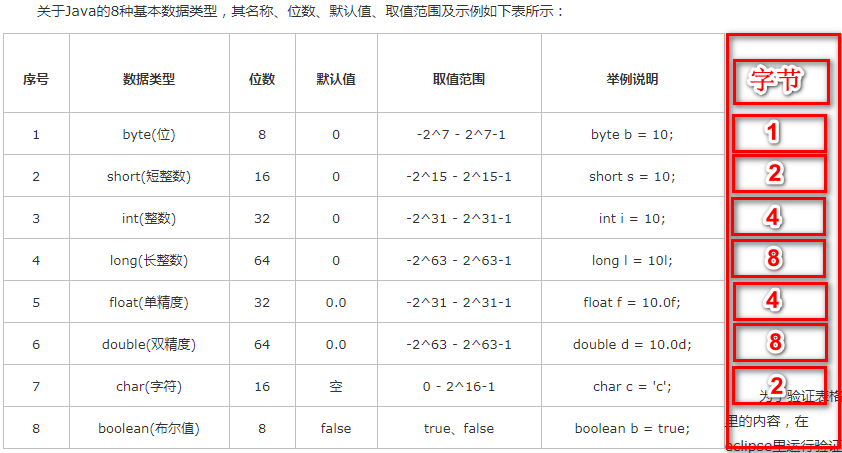一、RandomAccessFile
RandomAccessFile类可以说是Java语言中功能最为丰富的文件访问类,它提供了众多的文件访问方法。RandomAccessFile类支持"随机访问"方式,可以跳转到文件的任意位置处读写数据。要访问一个文件的时候,不想把文件从头读到尾,而是希望像访问一个数据库一样地访问一个文本文件,使用RandomAccessFile类是最佳选择。
RandonAccessFile类里面有个位置指示器,指向当前读写处的位置,当已经读写了n个字节后,该指示器将指向这n个字节后的下一个字节处。刚打开文件时,文件指示器指向文件的开头处,也可以移动文件指示器的位置,随后的读写将从新的位置开始。
RandomAccessFile类在文件随机(相对于顺序)读取时有很大的优势,但该类仅限于操作文件,不能访问其他得IO设备,如网络、内存映像等。
二、RandomAccessFile类的构造方法
RandomAccessFile类为用户提供了两种构造方法:
1、RandomAccessFile(File file, String mode)
2、RandomAccessFile(String name, String mode)
其实第二种构造方法也是new一个File出来再调用第一种构造方法,建议使用第一种构造方法,因为第一篇文章就说了File是IO的基础,有一个File不仅仅可以通过RandomAccessFile对文件进行操作,也可以通过File对象对文件进行操作。至于mode,Java给开发者提供了四种mode:

注意第二点"rw"模式,对rw模式的解释意味着Java并不强求指定的路径下一定存在某个文件,假如文件不存在,会自动创建。
三、RandomAccessFile类中的方法
RandomAccessFile中有如下一些常用方法:
| 方 法 | 作 用 |
| void close() | 重要,关闭此随机访问文件流并释放与该流关联的所有系统资源 |
| FileChannel getChannel() | 返回与此文件关联的唯一FileChannel对象,NIO用到 |
| long getFilePointer() | 返回此文件中的当前偏移量 |
| long length() | 返回此文件的长度 |
| int read() | 从此文件中读取一个数据字节 |
| int read(byte[] b) | 将最多b.length个数据字节从此文件读入byte数组,返回读入的总字节数,如果由于已经达到文件末尾而不再有数据,则返回-1。在至少一个输入字节可用前,此方法一直阻塞 |
| int read(byte[] b, int off, int len) | 将最多len个数据字节从此文件的指定初始偏移量off读入byte数组 |
| boolean readBoolean() | 从此文件读取一个boolean,其余readByte()、readChar()、readDouble()等类似 |
| String readLine() | 从此文件读取文本的下一行 |
| void seek(long pos) | 重要,设置到此文件开头测量到的文件指针偏移量,在该位置发生下一个读取或写入操作 |
| int skipBytes(int n) | 重要,尝试跳过输入的n个字节以丢弃跳过的字节,返回跳过的字节数 |
| void write(byte[] b) | 将b.length个字节从指定byte数组写入到此文件中 |
| void write(byte[] b, int off, int len) | 将len个字节从指定byte数组写入到此文件,并从偏移量off处开始 |
| void write(int b) | 向此文件写入指定的字节 |
| void writeBoolean(boolean v) | 按单字节值将boolean写入该文件,其余writeByte(int v)、writeBytes(String s)、writeChar(int v)等都类似 |
四、RandomAccessFile实例
1、先定义一个Employee实体类:
public class Employee{ private String name; private int age; private static final int LEN = 8; public Employee(String name, int age) { //将名字固定在8个字节 if(name.length() > 8){ name = name.substring(0,8); }else{ //名字不够8个字节,用‘u0000’来补齐 while(name.length() < 8){ name = name + 'u0000'; } } this.name = name; this.age = age; } public String getName() { return name; } public void setName(String name) { this.name = name; } public int getAge() { return age; } public void setAge(int age) { this.age = age; } }
其中构造函数中将name固定在了8个字节,'u0000'表示是Character中的最小值,为空
/** * The constant value of this field is the smallest value of type * {@code char}, {@code 'u005Cu0000'}. * * @since 1.0.2 */ public static final char MIN_VALUE = 'u0000';
age为int类型,所占4个字节,所以name+age所占12个字节。
补充说明基本数据类型、位、字节之间的关系


2、举例说明
通过RandomAccessFile类将employee对象的name和age写进文件
public class Test { public static void main(String[] args) throws IOException { Employee employee1 = new Employee("zhangsan",10); Employee employee2 = new Employee("lisi",11); Employee employee3 = new Employee("wangwu",12); File file = new File("D:" + File.separator + "employee.txt"); RandomAccessFile randomAccessFile = new RandomAccessFile(file,"rw"); randomAccessFile.writeBytes(employee1.getName()); randomAccessFile.writeInt(employee1.getAge()); randomAccessFile.writeBytes(employee2.getName()); randomAccessFile.writeInt(employee2.getAge()); randomAccessFile.writeBytes(employee3.getName()); randomAccessFile.writeInt(employee3.getAge()); randomAccessFile.close(); } }
通过RandomAccessFile类随机读取刚刚写入的文件(通过seek方法和skipBytes方法随机读取文件)
public class Test { public static void main(String[] args) throws IOException { File file = new File("D:" + File.separator + "employee.txt"); RandomAccessFile randomAccessFile = new RandomAccessFile(file,"rw"); int length = 8; String name = ""; //跳过第一个人的信息,(姓名占8个字节,age(int)占4个字节) randomAccessFile.skipBytes(12); System.out.println("第二个人的信息:"); for(int i = 0; i < length; i++){ name = name + (char)randomAccessFile.readByte(); } System.out.println("姓名是:" + name); System.out.println("年龄是:" + randomAccessFile.readInt()); //重新定位到文件的开头 randomAccessFile.seek(0); System.out.println("第一个人的信息:"); name = ""; for(int i = 0; i < length; i++){ name = name + (char)randomAccessFile.readByte(); } System.out.println("姓名是:" + name); System.out.println("年龄是:" + randomAccessFile.readInt()); //此时,randomAccessFile的位置指示器已指向第一个人的信息结束的字节码处 //跳过第二个人的信息(12个字节码 == 姓名的字节码 + int类型的age所占的4个字节码) randomAccessFile.skipBytes(12); System.out.println("第三个人的信息:"); name = ""; for(int i = 0; i < length; i++){ name = name + (char)randomAccessFile.readByte(); } System.out.println("姓名是:" + name); System.out.println("年龄是:" + randomAccessFile.readInt()); randomAccessFile.close(); } }
结果:
第二个人的信息: 姓名是:lisi 年龄是:11 第一个人的信息: 姓名是:zhangsan 年龄是:10 第三个人的信息: 姓名是:wangwu 年龄是:12
最后,RandomAccessFile使用完一定要及时close()。
参考资料:https://www.cnblogs.com/xrq730/p/4888288.html